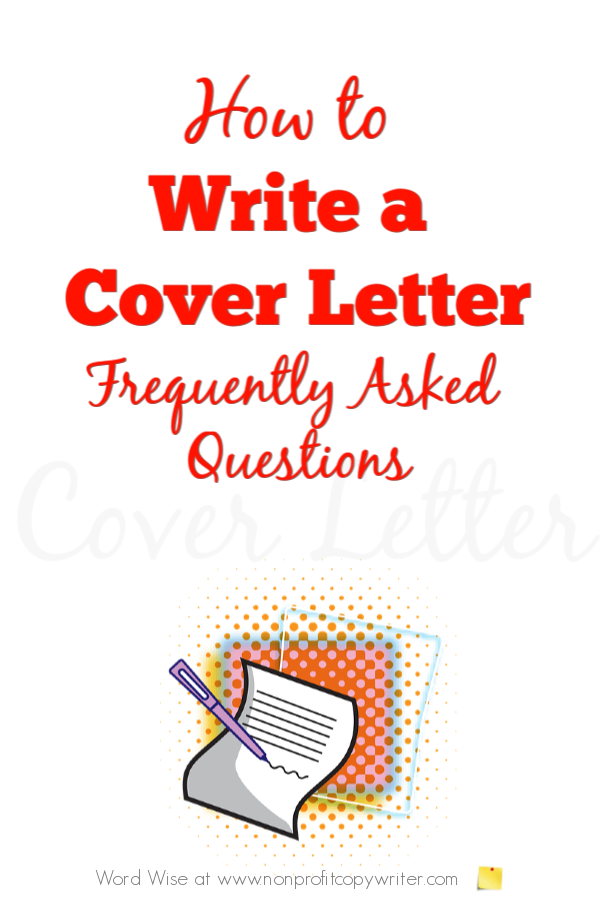Save Time: Get 5 Simple Writing Tips
you can put to use in 10 minutes
How To Write a Cover Letter: FAQs
Award-winning writer Kathy Widenhouse has helped hundreds of nonprofits and writers produce successful content , with 750K+ views for her writing tutorials. She is the author of 9 books. See more of Kathy’s content here.
Updated 2.1.25
“I only need to know how to write a cover letter when I’m job hunting.” That’s a common misconception.
I write cover letters for clients almost every week – cover letters that introduce an offer, accompany a grant application, or summarize an information packet.
I also write cover letters to clients that accompany a completed draft or project. And I write cover letters to prospects offering my freelance services. (Kinds of letters that freelancers write.)
That’s why I can say unequivocally that knowing how to write a cover letter is an essential content writing and copywriting skill – a skill that’s riddled with questions.
Let’s answer some of them.
How to Write a Cover Letter: FAQs
Q: What is a cover letter?
A cover letter is a one-page introduction. It’s got one simple job to do: get the reader to take the next step.
That’s why a cover letter always accompanied by other content, such as a resume (when it’s part of a job application), sales materials, or other supporting information that makes an Ask.
Q: When should I write a cover letter?
- When you’re applying for a job
- When you’re prospecting for freelance clients
- When you’re sending an appeal package or sales package
- When you’re submitting a grant application
- When you’re sharing an information or fulfillment package of various types
- When you’re sending a draft or final project delivery to a client
Q: What is the right length for a cover letter?
Your cover letter should be formatted on one page, but it should fill only 75 percent of the document. Let white space fill the rest of page.
The body should be 200-300 words and consist of three to four paragraphs. A reader should be able to review it in 60 seconds or less. Where possible, use bullet points. (Here’s how to write a cover letter step by step.)
Q: Why should a cover letter be so brief?
A two-page cover letter is too long because it’s more than an introduction. That much content likely replicates what’s in the rest of your package.
A full-page cover letter (with no white space) is too long because it lacks conciseness.
A good cover letter distills your introduction into an engaging, succinct, or snappy summary.
Q. How is a cover letter different from a business letter?
A business letter is any communication written for commercial reasons. That means a cover letter is one kind of business letter.
Q: Is it okay to send a generic cover letter?
No. Never.
“Dear Sir” or “To Whom It May Concern” are impersonal – and deadly. What reader wants to be faceless? Your salutation should address a real person. If you’re a job seeker, then address your cover letter to the hiring manager, department head, or HR director. If you’re a freelancer, then address your letter to the publication editor or the organization’s marketing director, communications director, or development coordinator. If you don’t have a name, then do a bit of research. Dig into the website or make a quick phone call to get a name and a title.
Equally lethal to a generic salutation: all-purpose letter content that can apply to any reader (“I am applying for the job you posted.”) Your well-written cover letter should include keywords and concepts that are specific to the employer, prospect, or client. That means you need to do a bit of homework to incorporate those reader-specific terms.
Q: What’s a good cover letter writing format?
- Heading
- Salutation
- Introductory Paragraph
- Letter Body (1-3 paragraphs)
- Closing Paragraph
- Signature
See more about writing a good cover letter here and use this simple Cover Letter Writing Guide to know how to write a cover letter step-by-step.
More Letter Writing Tips
30 Kinds of Letters You Need to Know How to Write ...
Beyond Yours Truly: Business Letter Closings That Mark You as a Pro ...
Writing a Good Cover Letter: a step-by-step guide ...
Cover Letter Writing Tip: get the reader to take one step ...
How to Write a Letter of Inquiry ...
Letter Writing Tip: try this opening line ...
More letter writing tips on our Pinterest board ...
Return from How to Write a Cover Letter FAQs to Nonprofit Copywriter home
As an Amazon Associate I earn from qualifying purchases.
Share This Page

Named to 2022 Writer's Digest list
BEST GENRE/NICHE WRITING WEBSITE


Stop Wasting Time!
Grab your exclusive FREE guide, "5 Simple Writing Tips You Can Put to Use in 10 Minutes or Less"












